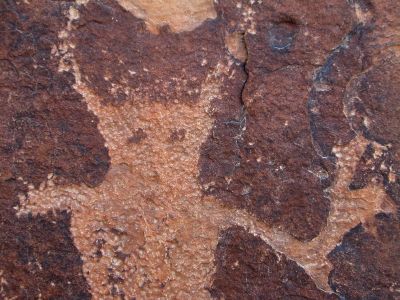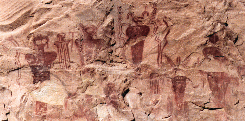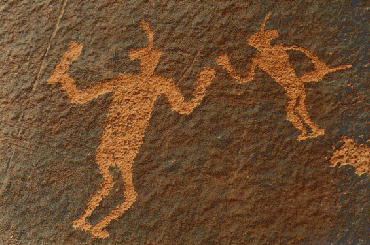(Mostly Barrier Canyon Style) Rock Art Photo Collection

(Rochester Creek Panel)
Last updated: Feb 2006

(Rochester Creek Panel)
Last updated: Feb 2006
What's new:
|
www.flickr.com
This is a Flickr badge showing photos in a set called All Rock Art. Make your own badge here.
|
What follows are detailed photographs of various rock art sites I've visited (along with my wife Amy and my brother Dave). Most of these sites (with the exception of the "fighting man" panel for instance) are, or are at least similar to, "Barrier Canyon Style" (BCS). This style is generally attributed to hunter-gatherers that lived in portions of Utah from about 4000 to 1500 years ago.
Many of the following photos were taken by Dave. Before using any of Dave's photos, please contact Dave at: david.e.lee1@jsc.nasa.gov.

Buckhorn Wash |
Another Grand County
|
San Rafael Swell Site 1 |
San Rafael Swell Site 3
|
In this area there are at least seven Barrier Canyon style panels within a couple hours walking distance, so it's likely that the later artists were familiar with the earlier panels. Yet there's a great deal of diversity in styles here, from the one of the most simple to one of the most detailed panels I've seen. Dave and I have reasonable pictures of 6 of these panels.





I don't have good pictures for one of these panels, the "Snake in Mouth" panel (Grand Country Panel 6 in my scheme of things) but you can see pictures of it on Doak Heyser's Rock Art Gallery:
Full panel and a closeup of the "Snake in Mouth" panel.

These are
terribly old, gifs scanned from photos, so they are quite low quality,
sorry. I will replace them soon.

This used to be the title image on this page.
It also appears (with permission!) on the cover of McCauley and Lawson's
Bringing Ritual to Mind : Psychological Foundations of Cultural Forms

These pages are best viewed with a tabbing browser (Mozilla, the new versions of Netscape based on Mozilla, Safari, etc.) even though I first wrote some of them at least 5 years before I'd seen such a thing. When possible, for each panel I have several "zoom" levels of various parts of the panel, from the entire panel to individual figures, and a tabbed browser will make sorting through all this a lot easier (less reloading of large images). Be warned, ALL of these images are large, in the 150kB range at least, and some of the full res scans are in the megabyte range. Don't go further if you have a slow connection unless you are prepared to wait.
If you stumble across one of these or any rock art site, please take great care and show respect for the site (not only the panel of course but the area around it as well)! Barrier Canyon rock art sites are rare, perhaps 200 of them representing thousands of years of North American history -- each one could be the only information we have about an entire generation of people. These are invaluable works of art. In any museum there would be a guard to tell you not to get too close, and the guard would certainly throw you out or even arrest you if you tried to touch. Just go ahead and pretend the guard is there at the site with you! It's also often pointed out that these sites were quite obviously of great spiritual importance to the people who created them, but somehow people don't seem to get it. Put simply, don't do anything to them you wouldn't do to a piece of art in any other (especially your) place of worship. Don't touch, don't start camp fires, be careful even of where you step. In general you get better pictures if you aren't right up next to the panel anyway, so take a telephoto!
If that's not enough for you, depending on where the panel is (state of federal land) the fine for damaging rock art is, I think, $20,000 and/or up to three times the cost for art conservators to restore the panel.
The scans of Dave's photos and some of my older ones were done by photo developers, but they generally do a really bad job with either rock art (too few colors for the software to make sense of) or slide film (denser and more difficult to scan than print film) so the combination is usually fatal! Thus I recently got a Nikon Coolscan IV ED film scanner which does quite nicely with slides. I touch up pictures in anything from xv to Gimp or Photoshop. Recently mostly Photoshop.

